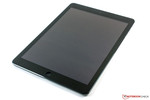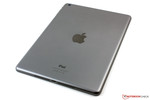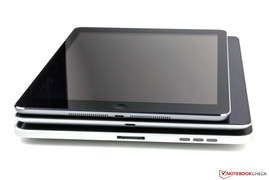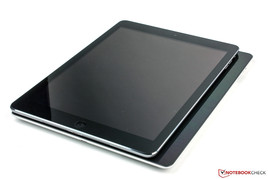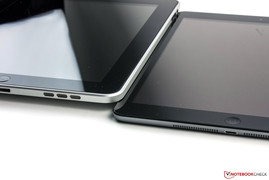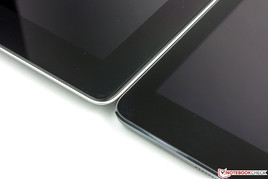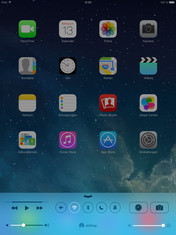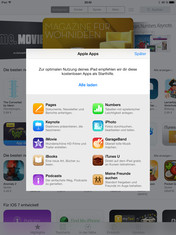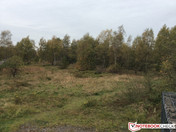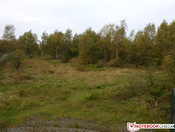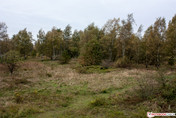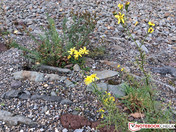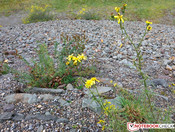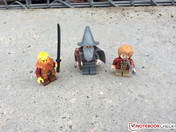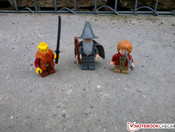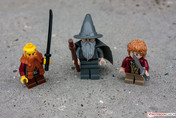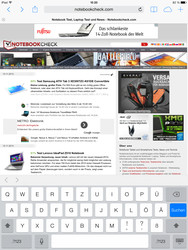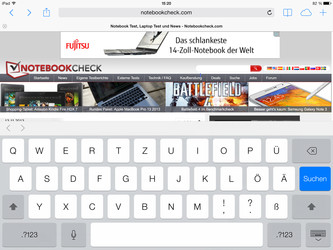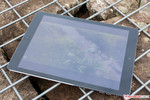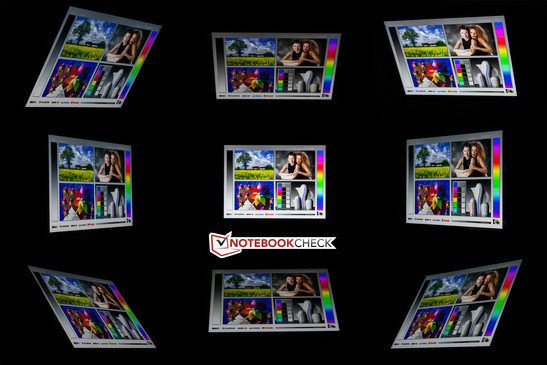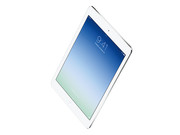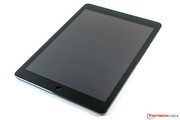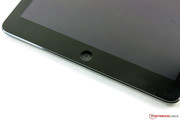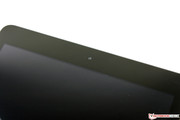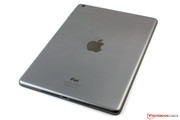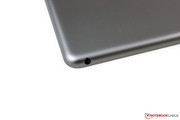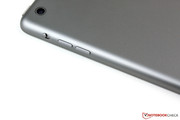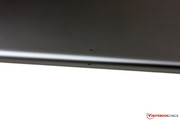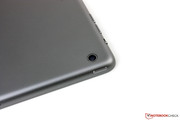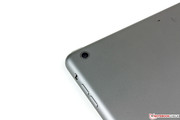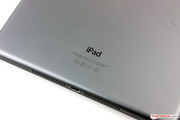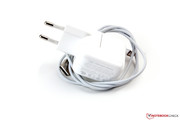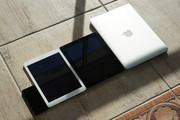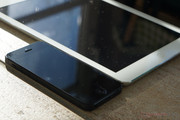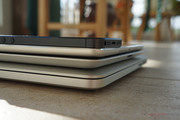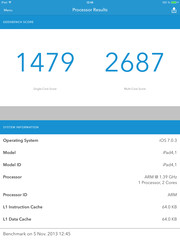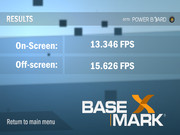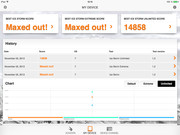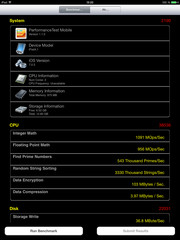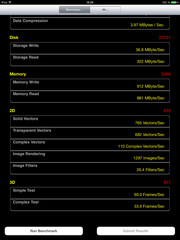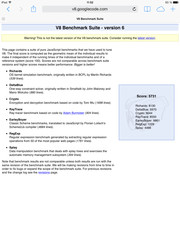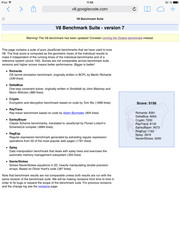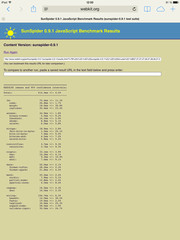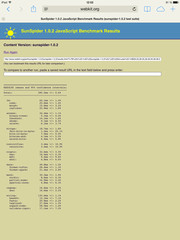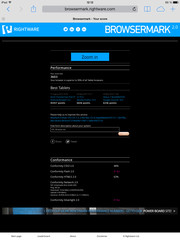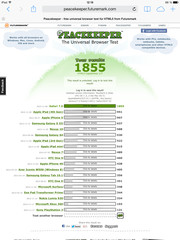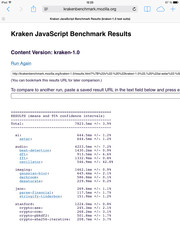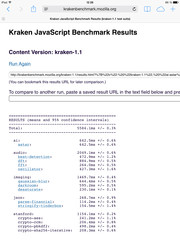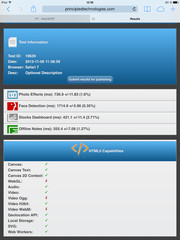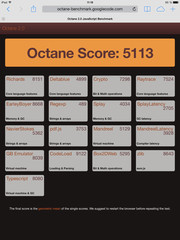Review Apple iPad Air Tablet

For the original German review, see here.
Fresh on the market, the new iPad Air is quite the turn-around, especially in terms of its design. Its two predecessors had some serious weaknesses in this area; the Cupertino-based company is such a giant when it comes to aesthetics, we expected a thinner device sooner. But the new device turns over a new leaf. Besides its trimmer figure, the recently released tablet is considerably lighter too. Apple's new A7 processor is also on board, still supported by 1024 MB of working memory. In terms of storage space, everything is as it was. There are four versions with 16, 32, 64 or 128 GB of flash storage. With a base price of 479 Euros (~$650), each time you double the memory you will pay another 100 Euros (~$135). The optional LTE modem costs a further 120 Euros (~$162). Our test model is equipped with 16 GB and is Wi-Fi-only. With those specs, the new iPad Air is about 20 Euros (~$27) cheaper than its predecessor.
Despite the fact that the battery is considerably smaller, it should still last ten hours. The display's optimized power draw is probably largely responsible for this feat. The iPad Air has a wide array of competitors from every price class. High-class models, like the Google Nexus 10 or the Samsung Galaxy Note 10.1, run on the Android operating system; though with their Surface 2, Microsoft also offers a very good tablet that runs on Windows 8.1 RT. Those who are not prepared to invest more than 450 Euros (~$609) in a tablet will also find a number of devices that are substantially more cost-effective, though it is undeniable who their role model is. The Archos 97 Titanium HD (259 Euros; ~$350) and the Bullman Tab 9 AQQR Retina (299 Euros; ~$400) both possess a Retina display as well, yet are considerably cheaper.
Case
The Apple iPad Air measures 240 x 169.5 x 7.5 millimeters (9.45 x 6.67 x 0.30 inches; height x width x depth). That means it is not only significantly thinner than its predecessor, but also a little narrower. The iPad 4 was still a stately 185.7 mm wide (7.3 inches). Apple primarily thinned out the panel frames on the long sides of the device. That does not leave much room for your thumbs to rest on while holding the tablet, but the engineers from Cupertino already considered that in the previous generation and outfitted the touchscreen with thumb recognition. When this digit touches the screen, the contact is not recognized or processed as input. This solution works very well in practice.
Apple has once again selected aluminum as the material for their unibody case. The case is available in the colors "space gray" and "silver". The manufacturing quality is simply top-notch -- the Surface 2 cannot quite keep up here, though it does hide fingerprints better. The design gives the impression of being from one single cast, and the metal feels wonderful. It fits together flawlessly in every area, and the iPad proves to be absolutely unfazed by our attempts to twist it. In our pressure tests, its only response was the appearance of minor waves on the panel when we pressed hard on the backside. Apple also advertises their touchscreen's oil-repellent coating, but it did not seem to be of any advantage. Fingerprints are easily visible and essentially unavoidable.
Connectivity
In terms of connections, nothing has changed since the tablet's predecessor. The multi-functional Lightning connector is now flanked by two stereo speakers. The 30-pin connection is a modified USB 2.0 port that can also read audio and Firewire signals. The device is of course also outfitted with the mandatory headphone jack. A real USB port or a microSD slot for storage expansion would have been nice, but Apple is holding to their policies and continuing to omit these features.
The switch on the right side of the device can be configured in the settings. Here you can choose whether the switch mutes the speakers or controls the rotation-lock.
Software
Apple iOS 7.0.3 is installed on our review device. The operating system received a substantial makeover compared to the versions preceding it. It is now considerably brighter and is outfitted with a quick access toolbar, accessible via a simple swipe across the bottom edge of the screen. The tool is somewhat reminiscent of the Windows Charms bar. Otherwise, not too much has changed about the iOS' operation. Apple stays true to their successful concept, which is a good thing. Unlike with the iPhone 5c and 5s, however, we fell victim to a bug in our iPad Air tests. The Safari browser continuously crashed during our battery life tests -- but we will cover that in depth later. Because the app icons are not as densely packed on the screen as they are on the iPhones, the screen image feels much calmer and not excessively colorful.
The Californian company now also lavishes a full-blown Office suite on their customers and offers the Pages, Numbers and Keynote apps free of charge. Other programs like GarageBand and iPhoto are now free as well.
Communication
The Apple iPad Air accesses the Internet via its integrated Ethernet module. This module supports the IEEE 802.11 standards a/b/g/n and transmits at 2.4 and 5.0 GHz. The newer, faster ac standard is not supported. The module's reception range is very good. Even 20 meters (~66 feet) from the router (Fritz!Box 6360), we still got a reasonably strong signal, though loading web pages at that distance took considerably longer. The Surface 2 does a little better here.
Bluetooth version 4.0 is also on board. NFC, on the other hand, is not. Apple also offers a version of their iPad Air with LTE, which covers all the common frequency bands. You can also access the Internet via the quick standard HSPA+.
We also tested the iPad Air's proficiency with VoIP calling. Here the tablet does everything right. Thanks to the two integrated microphones on either side of the device, the speech quality is superb, and the video quality is good as well. The tablet also switches between its front and rear cameras rapidly. With these traits, we would not have a single reservation in recommending the device for use with VoIP -- if the image noise were not quite so strong in low lighting.
Cameras & Multimedia
Apple did not change too much when it comes to the cameras. The front camera still has a resolution of 1.2 MP (1280x960 pixels) and is primarily intended for video calls. It fulfills this duty quite reliably. For photos, on the other hand, the camera's resolution is simply too low.
The so-called iSight camera on the backside of the device has a resolution of 5 MP (2560x1920 pixels), and in good lighting situations, it captures snapshots very well. For close-ups, however, it lets in too much light and tends to generate slightly overexposed images. The lens records videos in Full HD (1920x1080 pixels). While experimenting with this function, it became especially apparent to us that the iSight camera was designed first and foremost with video calls in mind, as the picture is very prone to blurring during fast pans. It is quite evident here that there is no image stabilizer. Also, the camera has neither an assist light nor a flash, so it is impossible to take pictures in the dark.
Accessories
The accessories included in the packaging are as modest as usual. Alongside a modular power supply with a power rating of 12 Watts, Apple sticks in a connector cable compatible with the iPad Air, which serves the dual purpose of charging the tablet and transferring data to a computer. That about covers all of it.
There is a whole slew of additional accessories available for purchase, however. The Smart Cover (39 Euros; ~$52) or Smart Case (49 Euros; ~$66) are sensible add-ons for the iPad Air. You can also purchase a drone (350 Euros; ~$470) and/or a number of other useful accessories in the Apple Store.
Warranty
Apple offers a 12-month warranty on their iPad Air. This warranty is extended to two years in Europe. The manufacturer also provides 90 days of telephone support.
The Apple Care+ warranty extension (99 Euros; ~$130) extends the warranty to 24 months and must be acquired within 90 days of the device's purchase date. It covers up to two unintentional damages. Apple still charges an additional 49 Euro (~$66) service fee each time the device needs to be repaired.
Input Devices & Operation
The Apple iPad Air's virtual keyboard profits from the panel's large workspace area (a product of its high resolution) and its 4:3 format. At 10 x 12 mm (~0.39 x 0.47 inches; length x height) in portrait format, the keys are not especially large, but they are comfortably sized. About 70% of the screen remains visible in this format, so it is a good option for surfing the web. In landscape format only about 50% of the screen remains visible, but the key size grows to 12 x 14 mm (~0.47 x 0.55 inches). This layout is especially useful for writing emails or other short texts. Because the developers left ample space between the individual keys, typing errors are unlikely. All in all, Apple does a good job here.
The 9.7-inch touchscreen supports up to ten separate inputs simultaneously and translates them quickly and precisely. The user's fingertips glide over the glass surface with little resistance. The Microsoft Surface 2, however, does this even better -- but that is a highly specific criticism.
Display
Nothing appears to have changed about the display either. Its diagonal still measures 9.7 inches, and it still has a resolution of 2048x1536 pixels. That corresponds to an aspect ratio of 4:3 and a pixel density of 264 PPI. The latter is so high that you have to zoom in good and close to a block of text to start seeing the individual pixels building the letters.
Behind the promising Retina Display name hides an IPS panel. Whether it is already equipped with the energy-saving IGZO technology (Indium Gallium Zinc Oxide) is something only the Californian company knows. It is not making any statements regarding these conjectures, but DisplayMate's panel specialists claim the iPad Air is in fact outfitted with the new technology.
When it comes to brightness, the tablet is considerably stronger than its predecessors are and now shines at a maximum of 473 cd/m² (iPad 4, 327 cd/m²). With a 90% similarity across the screen, the brightness distribution is considerably more uniform as well (iPad 4, 84%). The Surface 2 (max. 388 cd/m², 89%) cannot quite keep up here either. Subjectively, though, the difference between the two competitors is not noticeable here. We are pleased to report that we did not observe any screen bleeding on the iPad Air. Many customers have complained about the yellow background lighting shining through around the rim of the panel, but we did not detect that on our test device either.
| |||||||||||||||||||||||||
Brightness Distribution: 90 %
Center on Battery: 473 cd/m²
Contrast: 1154:1 (Black: 0.41 cd/m²)
ΔE ColorChecker Calman: 2.82 | ∀{0.5-29.43 Ø4.79}
ΔE Greyscale Calman: 1.45 | ∀{0.09-98 Ø5}
Gamma: 2.47
CCT: 6768 K
At 0.41 cd/m², the Apple iPad Air's black value is not incredible, but it is certainly respectable. If you consider that number in conjunction with the panel's high brightness, it is perfectly acceptable. Also, the iPad Air's black value is better than the Surface 2's (0.51 cd/m²). The Android competition is not substantially better either. The Sony Xperia Tablet Z (0.39 cd/m²) has a lower black value than that of the iPad Air. The Nexus 10 (0.58 cd/m²), on the other hand, distinguishes itself in this discipline. A good black value is especially important for displaying video, as a deeper black improves the image. Compared to the competition, the iPad Air does this very well, though due to its 4:3 format, the tablet is forced to display black edges. At 1154:1, the device's contrast is very good. Subjectively, the colors are very rich and bold -- an assessment the data supports.
The iPad Air's color display is exemplary. Apple does not make any specific statements regarding the tablet's color space coverage, but they indicate that it covers the sRGB color space almost completely. The panel's calibration straight from the factory is also very good. At 6768 K, the device approaches the ideal color temperature. The RGB Balance has certainly earned its name as well, and the color accuracy is excellent. Blue is the only color to exceed a DeltaE deviation of 3, which a trained eye would recognize upon close inspection. With mixed colors, too, the iPad Air reaches an average DeltaE deviation of 3, which is still within the ideal range. The grayscale is even better -- here the dE comes to less than 2 on average. With these fantastic characteristics, the tablet is a perfect fit for professionals who need a panel's color display to be precise.
The iPad Air proves to be well suited for outdoor use. The excellent brightness and first-class contrast ratio work together to make the screen visible even in bright environments. Only under direct sunlight is it more difficult to make out the tablet's screen content. The display's reflective surface is primarily responsible for that problem. It is still possible to read the iPad's screen content under those conditions, but it gets rather tiring for your eyes. Otherwise, the Air masterfully adapts to any and every light environment.
The IPS display technology at work in the Apple iPad Air should lend it outstanding viewing angle stability. That is certainly the case. Starting at a viewing angle of about 110°, however, reflections accentuate the space between the glass surface and the panel. If you continue to widen the angle, the image genuinely starts to distort. Because the iPad's display is also reflective in bright sunlight, it is simply not possible to read the screen content from extreme viewing angles. In everyday use, however, you will hardly ever notice this first shortcoming -- nor will you see the weak glow the IPS panel emits when the screen displays black.
Performance
The Apple iPad Air runs on the same processor as the iPhone 5s. The 64-bit Apple A7 CPU clocks about 100 MHz faster than it does in the smartphone, and in combination with the integrated Imagination PowerVR G6430 GPU, it really knows how to flex its muscles. Along with OpenGL 4, the GPU also supports OpenGL ES 3.0 and DirectX 10. The tablet has 1024 MB of working memory.
The device's processor performance is very good. Despite being just a dual-core, the iPad Air still rushes past its speedy smartphone competitors' Snapdragon 800 processors, even though they have four cores and higher clock frequencies. At least this is the picture the Linpack benchmark paints, in which the tablet reaches a multi-thread score of 977 MFLOPS. Even a performance giant like the Sony Xperia Z1 (964 MFLOPS) cannot quite keep up here. Unfortunately, this is the first tablet with the quick SoC to enter our data bank, so we can only compare it with a smartphone. Devices that have yet to appear on the market, like the Nokia Lumia 2520, will also run on this SoC.
The 3DMark Unlimited benchmark's physics test reveals a different picture. Here the iPad Air only scores 8520 points -- ranking below even its own predecessor (8850 points). Since both models' processors clock at the same frequency, this is probably simply related to the fact that measurement can be imprecise. Things look different when we compare our review device with the Surface 2 (12,692 points) and the Xperia Z1 (Snapdragon 800, 14,477 points). Here the Apple product is clearly left in the dust, as the Windows and Android devices achieve nearly twice its score.
The iPad Air is a master at graphics computations. In off-screen benchmarks, like the 3DMark Unlimited graphics test (18,868 points) or the GFX Bench 2.7 (27 fps), the tablet is faster than all the rest of the competition. With 14,812 points, the Surface 2 (Tegra 4) scores considerably lower, and the Xperia Z1 (17,966 points) is somewhat slower as well. But because the iPad Air has a higher panel resolution, its on-screen score in GFX Bench is a little lower than that of the competition.
The tablet's storage medium is very quick, if you look at the data from PassMark. At about 322 MB/s, its linear read speed is quite fast. The Surface 2 only reaches 139 MB/s in another benchmark. The Samsung Galaxy S4 is substantially swifter (413 MB/s), achieving the same numbers as an SSD in this area.
All in all, the new iPad makes a very good impression here, and for the time being it can take the crown for the strongest graphics chipset. The tablet also has sufficient performance reserves to retain its usefulness in the coming years.
| 3DMark | |
| 1280x720 offscreen Ice Storm Unlimited Score (sort by value) | |
| Apple iPad Air 1 2013 | |
| Apple iPad 4 | |
| Microsoft Surface 2 | |
| Apple iPhone 5S | |
| Apple iPhone 5S | |
| Sony Xperia Z1 | |
| 1280x720 offscreen Ice Storm Unlimited Graphics Score (sort by value) | |
| Apple iPad Air 1 2013 | |
| Apple iPad 4 | |
| Microsoft Surface 2 | |
| Apple iPhone 5S | |
| Apple iPhone 5S | |
| Sony Xperia Z1 | |
| 1280x720 offscreen Ice Storm Unlimited Physics (sort by value) | |
| Apple iPad Air 1 2013 | |
| Apple iPad 4 | |
| Microsoft Surface 2 | |
| Apple iPhone 5S | |
| Apple iPhone 5S | |
| Sony Xperia Z1 | |
| GFXBench (DX / GLBenchmark) 2.7 | |
| 1920x1080 T-Rex Offscreen (sort by value) | |
| Apple iPad Air 1 2013 | |
| Bullman Tab 9 AQQR Retina | |
| Sony Xperia Tablet Z | |
| Google Nexus 10 | |
| Apple iPad 4 | |
| Toshiba eXcite Pro AT10LE-A-108 | |
| Microsoft Surface 2 | |
| Apple iPhone 5S | |
| Sony Xperia Z1 | |
| T-Rex Onscreen (sort by value) | |
| Apple iPad Air 1 2013 | |
| Bullman Tab 9 AQQR Retina | |
| Sony Xperia Tablet Z | |
| Google Nexus 10 | |
| Apple iPad 4 | |
| Toshiba eXcite Pro AT10LE-A-108 | |
| Microsoft Surface 2 | |
| Apple iPhone 5S | |
| Sony Xperia Z1 | |
| Geekbench 3 | |
| 32 Bit Single-Core Score (sort by value) | |
| Apple iPad Air 1 2013 | |
| Apple iPad 4 | |
| Apple iPhone 5S | |
| Sony Xperia Z1 | |
| 32 Bit Multi-Core Score (sort by value) | |
| Apple iPad Air 1 2013 | |
| Apple iPad 4 | |
| Apple iPhone 5S | |
| Sony Xperia Z1 | |
| Linpack Android / IOS | |
| Single Thread (sort by value) | |
| Apple iPad Air 1 2013 | |
| Archos 97 Titanium HD | |
| Bullman Tab 9 AQQR Retina | |
| Sony Xperia Tablet Z | |
| Google Nexus 10 | |
| Apple iPad 4 | |
| Toshiba eXcite Pro AT10LE-A-108 | |
| Apple iPhone 5S | |
| Sony Xperia Z1 | |
| Multi Thread (sort by value) | |
| Apple iPad Air 1 2013 | |
| Archos 97 Titanium HD | |
| Bullman Tab 9 AQQR Retina | |
| Sony Xperia Tablet Z | |
| Google Nexus 10 | |
| Apple iPad 4 | |
| Toshiba eXcite Pro AT10LE-A-108 | |
| Apple iPhone 5S | |
| Sony Xperia Z1 | |
In our browser benchmarks, running Apple's own Safari browser, the iPad Air proves to be a formidable surfing machine. Not a single competitor can hold a candle to our review device in any of the tests, except that the Microsoft Surface 2 achieves a similar score in the Sunspider 1.0 benchmark. The Californian company's tablet turns out to be an excellent device for surfing the web -- and its high display resolution only adds to that. Websites look good in their "classic" form, so there is no need to fall back on mobile versions. The missing flash support remains the tablet's only shortcoming in this area.
| Peacekeeper - --- (sort by value) | |
| Apple iPad Air 1 2013 | |
| Bullman Tab 9 AQQR Retina | |
| Sony Xperia Tablet Z | |
| Google Nexus 10 | |
| Microsoft Surface 2 | |
| Toshiba eXcite Pro AT10LE-A-108 | |
| Octane V1 - Total Score (sort by value) | |
| Apple iPad Air 1 2013 | |
| Bullman Tab 9 AQQR Retina | |
| Sony Xperia Tablet Z | |
| Microsoft Surface 2 | |
| Toshiba eXcite Pro AT10LE-A-108 | |
| Sunspider - 1.0 Total Score (sort by value) | |
| Apple iPad Air 1 2013 | |
| Bullman Tab 9 AQQR Retina | |
| Sony Xperia Tablet Z | |
| Microsoft Surface 2 | |
| Toshiba eXcite Pro AT10LE-A-108 | |
| Browsermark - --- (sort by value) | |
| Apple iPad Air 1 2013 | |
| Archos 97 Titanium HD | |
| Bullman Tab 9 AQQR Retina | |
| Sony Xperia Tablet Z | |
| Google Nexus 10 | |
| Microsoft Surface 2 | |
| Toshiba eXcite Pro AT10LE-A-108 | |
| Mozilla Kraken 1.1 - Total (sort by value) | |
| Apple iPad Air 1 2013 | |
| Microsoft Surface 2 | |
| Toshiba eXcite Pro AT10LE-A-108 | |
* ... smaller is better
Games
Even demanding games are not a problem for the Apple iPad Air. The Imagination PowerVR G6430 integrated into the SoC performs very well and already supports the modern standard OpenGL ES 3.0, so even future releases should be playable on the tablet. All games can be enjoyed in their full splendor. Even the newest titles, like FIFA 14, Asphalt 8 or Infinity Blade III, are no hurdle for the Air.
The good touchscreen and excellent sensors only enhance the gaming experience and perform their duties flawlessly.
Emissions
Temperature
In idle mode, the Apple iPad Air's surface temperatures are quite moderate and reach a maximum of 31.4 °C (88.5 °F). At that temperature, the tablet grows a little warmer than most of its competitors, as the Surface 2 (28.3 °C; 82.9 °F) and the Nexus 10 (28.9 °C; 85.6 °F) both remain clearly below the 30 degrees Celsius (86 °F) mark -- but it's not as hot-headed as the Sony Xperia Tablet Z, which reaches up to 38.8 °C (101.8 °F) even in idle mode.
Under load, the iPad Air's temperatures rise to up to 42.1 °C (107.8 °F). That is even hotter than the iPad 4 (max. 40 °C; 104 °F), though given its thin build, that is not terribly surprising. Still, the Sony tablet is the only device that heats up more (max. 43.4 °C; 110.1 °F). The Surface 2 (max. 35.3 °C; 95.5 °F), the Archos 97 (max. 34.5 °C; 94.1 °F) and the Bullman AQQR (36.7 °C; 98.1 °F) all remain considerably cooler. We used the Relative benchmark to assess the iPad's temperatures. Unfortunately, this means that the tablet's maximum temperature is not some irrelevant figure -- while running games or other demanding applications, the iPad will frequently heat up to this degree.
(+) The maximum temperature on the upper side is 39.4 °C / 103 F, compared to the average of 33.7 °C / 93 F, ranging from 20.7 to 53.2 °C for the class Tablet.
(±) The bottom heats up to a maximum of 42.1 °C / 108 F, compared to the average of 33.2 °C / 92 F
(+) In idle usage, the average temperature for the upper side is 30 °C / 86 F, compared to the device average of 30 °C / 86 F.
Speakers
Two stereo speakers flank the Lightning connector on the bottom of the iPad Air. Their position is somewhat less than ideal, as a genuine stereo sound is not really possible in this configuration. However, it is practical that even if you hold the tablet in landscape format, only one of the speakers can be covered at a time.
Considering the size of the speakers, their sound is very good. High tones are clear and never distort, even at maximum volume. Even mid-tones are clearly audible, and the bass is so strong that it makes the whole device quiver. We were especially surprised by the bass, as the tablet's maximum volume is not terribly high. For a device of this size, these are excellent findings. The headphone jack's audio output is also immaculate.
Energy Management
Power Consumption
Compared to its predecessor, Apple improved their new iPad's efficiency. In idle mode, the tablet only consumes between 1.8 and 7.1 Watts, whereas the iPad 4 used 2.6 to 8.4 Watts. The Surface 2 (1.8 – 4.1 Watts) and the Sony Xperia Tablet Z (1.9 – 4.7 Watts) need substantially less energy here.
Under load, the iPad Air draws a maximum of 10.4 Watts. That is also an improvement, and is considerably less than Microsoft's tablet uses (max. 15.8 Watts), but because of the Air's high-performance graphics unit, it consumes substantially more than the Tablet Z (max. 5.6 Watts). Overall, Apple's engineers have done good work, as they managed to increase the tablet's performance while simultaneously lowering its energy consumption. Still, devices with a Qualcomm SoC remain a little ahead in this discipline.
| Off / Standby | |
| Idle | |
| Load |
|
Key:
min: | |
Battery Life
The Apple iPad Air has a 32.4 Wh battery at its command. Compared to its predecessor, the new tablet's battery is considerably smaller. Even so, the Californian company continues to offer a battery life of up to 10 hours. To measure a tablet's maximum battery run time, we dim the panel brightness to minimum and deactivate all communication modules except for Ethernet. We then run a script in the browser that simulates reading a book. The iPad holds out for almost an entire day -- a very good result. Unfortunately, this test does not resemble real everyday use, as the brightness was so low that the screen content was hard to read.
We determine a tablet's minimum battery run time by simulating the opposite scenario. We set the screen brightness to maximum, activate every wireless module and run Epic Citadel. The iPad still ran for over four hours.
Our video test produces results that are helpful for comparing devices. Here we keep the screen brightness at 150 cd/m², deactivate all wireless modules, and play the video "Big Buck Bunny" on an endless loop. The iPad allows you to enjoy almost eleven uninterrupted hours of Full HD film. This is a very good result, though it still does not match the Surface 2's 12:12 hours in this test.
Our WLAN test simulates another more practical scenario. Here, too, we adjust the brightness to 150 cd/m² and only activate Wi-Fi. In the browser, a script loads new websites every 40 seconds. Unfortunately, the test did not run smoothly -- the iPad Air closed the browser after several minutes. Since the test did not work on Safari nor on Google Chrome, we believe the operating system must be at fault. The fact that we could reproduce the problem on an iPad 3 with the same OS is additional support for that hypothesis. It is certainly possible that Apple will remedy the problem with one of their future updates. To get around the issue, we administered the test by hand and surfed the web for a good hour. We then projected the final result to be a battery run time of over nine hours -- once again, a good long life.
All in all, in terms of battery performance, the iPad Air makes a good impression. The ten-hour battery life Apple promises is entirely realistic.
Verdict
With the iPad Air, Apple once again delivers an outstanding tablet. The device both looks and functions as if it were born whole, operating system and software included. The Californian company once again manages to create a device that stands out from the crowd. The Retina display may not be especially new and innovative, but it was improved. Moreover, when it comes to professional image editing and presentation, there is not really an alternative to the iPad. Multimedia fans, on the other hand, should perhaps take a closer look at a different tablet. The Microsoft Surface 2 has a very good panel in 16:9 format without any annoying bars. In addition, the Surface 2's battery holds out longer during movie playback.
The iPad also has trouble with heat retention. Gaming fans will have a lot of fun on the high-performance tablet, but its surface temperatures will spike during the game. Also, though the speakers are actually very good, they are not well positioned.
Even so, the iPad remains the exemplary model of good manufacturing. Such a lightweight and thin device at this display size is simply impressive. The associates at iFixit still will not be happy with how difficult it is to service the tablet, of course. The great selection of apps and Apple tools that are now free of charge complete the package. Still, the Surface 2 lends itself better to productivity, not least because of its full Office suite and well-designed keyboards. The Microsoft device's biggest shortcoming is still its comparably lean app selection.
At long last, it will be worth it for iPad 2 owners to make an upgrade, since the Air is finally thinner and the most worthy successor to the device's second generation. How useful the processor's 64-bit architecture will be depends on future programs, but it is a logical step in the right direction.
Overall, Apple once again delivers a great product that functions well and looks attractive. Even if the competition has begun to closely resemble the pioneer from Cupertino, the iPad Air is still safe on the throne for the moment, though it does have to share it with the Surface 2.




